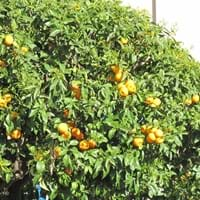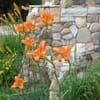Life Span
Perennial
Perennial
Type
Bulb or Corm or Tuber
Fruit
Origin
Southern Africa, South Africa
Southeastern Asia, India, China
Types
Cusick's camas, large camas
Not Available
Number of Varieties
Not Available
Habitat
meadows, moist forests, Open Plains
Farms, Warmer regions
USDA Hardiness Zone
8-10
9-11
AHS Heat Zone
Not Available
10-9
Sunset Zone
21,22
H1, H2, 8, 9, 12, 13, 14, 15, 16, 17, 18, 19, 20, 21, 22, 23, 24
Habit
Rosette/Stemless
Oval or Rounded
Flower Color
White, Yellow, Red, Blue, Purple, Pink, Lavender, Violet
White, Red, Purple
Flower Color Modifier
Bicolor
Bicolor
Fruit Color
Not Available
Orange
Leaf Color in Spring
Green
Dark Green
Leaf Color in Summer
Light Green
Dark Green
Leaf Color in Fall
Several shades of Green
Dark Green
Leaf Color in Winter
Light Green
Light Green
Leaf Shape
Long slender
Ovate
Plant Season
Spring, Winter
Spring, Summer, Fall, Winter
Sunlight
Full Sun, Partial Sun
Full Sun
Growth Rate
Medium
Medium
Type of Soil
Loam
Loam, Sand
The pH of Soil
Acidic, Neutral
Acidic, Neutral, Alkaline
Soil Drainage
Well drained
Well drained
Bloom Time
Early Spring, Spring, Late Winter, Indeterminate
Early Spring, Spring, Late Winter
Tolerances
Black Walnut Toxicity, Rabbit, Shade areas
Drought
Where to Plant?
Container, Ground, Pot
Ground
How to Plant?
chipping, Offsets, scooping, Twin scaling, Vegetative
Seedlings
Plant Maintenance
Low
Medium
Watering Requirements
Medium
Do not water frequently, Requires watering in the growing season, Water every two or three days during warmer months
In Summer
Lots of watering
Lots of watering
In Spring
Moderate
Moderate
In Winter
Average Water
Average Water
Soil pH
Acidic, Neutral
Acidic, Neutral, Alkaline
Soil Type
Loam
Loam, Sand
Soil Drainage Capacity
Well drained
Well drained
Sun Exposure
Full Sun, Partial Sun
Full Sun
Pruning
Remove damaged leaves, Remove dead branches, Remove dead leaves
Remove damaged leaves, Remove dead branches, Remove dead leaves
Fertilizers
All-Purpose Liquid Fertilizer, General garden fertilizer, Time release fertilizer
All-Purpose Liquid Fertilizer
Pests and Diseases
Pests and diseases free
Bacterial fruit blotch, Viruses
Plant Tolerance
Black Walnut Toxicity, Rabbit, Shade areas
Drought
Flower Petal Number
Single, Double, Semi-Double
Single
Fragrant Bark/Stem
No
Yes
Foliage Texture
Medium
Medium
Foliage Sheen
Glossy
Glossy
Attracts
Insects
Birds, Butterflies
Allergy
Asthma
no allergic reactions
Aesthetic Uses
Bouquets, Cottage Garden
Bonsai
Beauty Benefits
For treating wrinkles, Remove blemishes, Skin Problems
Not Available
Edible Uses
Sometimes
Yes
Environmental Uses
Air purification, Forms dense stands, Very little waste
Air purification
Medicinal Uses
Leucoderma, Urinary problems
Not Available
Part of Plant Used
Bulbs, Root
Fruits
Other Uses
Animal Feed, Decoration Purposes, Showy Purposes
Cosmetics, Culinary use
Used As Indoor Plant
Yes
No
Used As Outdoor Plant
Yes
Yes
Garden Design
Bedding Plant, Container, Cutflower, Mixed Border, Rock Garden / Wall
Container, Edible, Feature Plant, Fruit / Fruit Tree, Mixed Border, Screening / Wind Break, Topiary / Bonsai / Espalier, Tropical
Botanical Name
Hyacinthus orientalis
CITRUS sinensis 'Washington'
Common Name
Hyacinth, common hyacinth, garden hyacinth, dutch hyacinth
Navel Orange, Washington Navel Orange
In German
Hyazinthe
Navel Orange
In French
jacinthe
Navel Orange
In Spanish
jacinto
Naranja de ombligo o «navel»
In Greek
υάκινθος
Navel Orange
In Portuguese
jacinto
Navel Orange
In Polish
hiacynt
Pomarańcza
In Latin
et hyacinthinas,
Apelsīns
Phylum
Magnoliophyta
Magnoliophyta
Class
Liliopsida
Magnoliopsida
Order
Liliales
Sapindales
Family
Liliaceae
Rutaceae
Clade
Angiosperms, Monocots
Angiosperms, Eudicots, Rosids
Tribe
Not Available
Citreae
Subfamily
Scilloideae
Not Available
Number of Species
Not Available
Season and Care of Wild Hyacinth and Navel Orange
Season and care of Wild Hyacinth and Navel Orange is important to know. While considering everything about Wild Hyacinth and Navel Orange Care, growing season is an essential factor. Wild Hyacinth season is Spring and Winter and Navel Orange season is Spring and Winter. The type of soil for Wild Hyacinth is Loam and for Navel Orange is Loam, Sand while the PH of soil for Wild Hyacinth is Acidic, Neutral and for Navel Orange is Acidic, Neutral, Alkaline.
Wild Hyacinth and Navel Orange Physical Information
Wild Hyacinth and Navel Orange physical information is very important for comparison. Wild Hyacinth height is 10.20 cm and width 5.10 cm whereas Navel Orange height is 300.00 cm and width 300.00 cm. The color specification of Wild Hyacinth and Navel Orange are as follows:
Wild Hyacinth flower color: White, Yellow, Red, Blue, Purple, Pink, Lavender and Violet
Wild Hyacinth leaf color: Green
Navel Orange flower color: White, Red and Purple
- Navel Orange leaf color: Dark Green
Care of Wild Hyacinth and Navel Orange
Care of Wild Hyacinth and Navel Orange include pruning, fertilizers, watering etc. Wild Hyacinth pruning is done Remove damaged leaves, Remove dead branches and Remove dead leaves and Navel Orange pruning is done Remove damaged leaves, Remove dead branches and Remove dead leaves. In summer Wild Hyacinth needs Lots of watering and in winter, it needs Average Water. Whereas, in summer Navel Orange needs Lots of watering and in winter, it needs Average Water.





